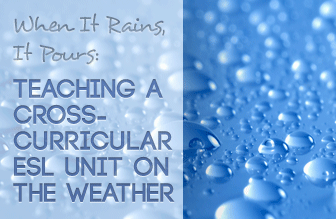☂ W: Weather Caster for a Day [Teacher Tips from A to Z]
![☂ W: Weather Caster for a Day [Teacher Tips from A to Z]](/uploads/posts/2011-08/1313561787_esl-weather.png)

The next time the weather comes up in your ESL classroom, try some of these activities that have to do with sun and sky. You can use these activities as they stand, or use them for inspiration for your own cross-curricular weather assignments.
Weather reports are a regular feature on the daily news, and those reports are a perfect tie in to the listening facet of your ESL unit on the weather. Whether you show your class a weather report from the area in which you are located or another area of the country or world, choose a weather segment (hundreds are available online) and play it for your class. If possible, use that weather segment to do a cloze exercise with your students. To prepare the activity, start with a transcript of the report, and replace every fifth word with a blank space. When your class views the weather report, give the modified transcript to your students, and challenge them to fill in the blanks as they listen to the report. The cloze activity will test your students’ general grammatical knowledge as well as listening skills. Another strategy, which is more weather intensive, is to replace all the specific weather vocabulary words with a blank and challenge your students to complete the transcript as they listen. Before you do this with your class, though, be sure you have reviewed the weather vocabulary with them.
Generally speaking, most areas of the United States experience four separate seasons each year. In January, we start with winter, which often includes snow and cold temperatures. When spring rolls around in March, flowers start to bloom, many areas have an increase in rain, and the temperatures begin to rise. Summer brings even hotter temperatures and a bounty of plant growth. Autumn arrives in September with changing leaves, cooler temperatures and windy weather. Depending on the home country of your students, your class may experience the four seasons for the first time when studying English in the U.S., or you may teach overseas where your students have only two seasons. In either case, the seasons are a great way to incorporate speaking and conversation into your ESL unit on the weather.
Divide your class into groups of three or four and ask them to discuss the weather that a person often experiences during each of the four seasons. If your students have never experienced snow or another element of seasonal weather, ask them to imagine what that season’s weather might be like. If your students are old enough to understand the concept, you can also ask each group to explain why the northern hemisphere experiences weather opposite of the southern hemisphere and why weather near the equator remains relatively consistent all year long.
Having sufficient English reading skills means more than reading pros texts. Your students should also be able to read charts, tables and maps. Weather maps can provide a great opportunity for your students to read non-text documents. Start by collecting several weather maps that span several days. You may want to save them from the newspaper or print maps that are available online. Give each pair of students a different weather map, and then ask them to plan the activities they will do as the weather allows. If possible, give them additional weather maps from locations around the world and challenge them to make plans for those areas as well.
Start your writing lesson by showing your class yesterday’s weather map of the country. Ask your students to point out differences in the weather in different areas of the country. Then, using that map, challenge students to write two paragraphs explaining how the weather affected the people living in two different regions. Students should start with the weather where they live, explaining how it affected them and their lives – what they wore, what they did during the day and how they may have spent their evenings. Then, have your students write a second paragraph about a person in another area of the country where the weather was different. In the paragraph, each student should answer the same questions and touch on the same ideas as when they described their own experiences. This is also a good time to review the concept of parallel structure between paragraphs with your class.
You can use weather as a tie in to the conditional tense during grammar class. First, review the conditional tense as it relates to the present. In the if clause, students should use “were” to describe the weather that differs from the weather at the moment. For example, if it is raining, students would start with “If it were sunny…” If it is sunny outside, encourage students to start their statements with “If it were raining…” Then challenge students to complete the sentence with an activity they would do under the fictional weather conditions using “would” as the helping verb. For example, “I would go to the beach.” Or “I would carry an umbrella.” In pairs, have your students go though every possible weather condition they can think of and create a conditional statement for each. Suggest that they use their weather vocabulary list to come up with as many possibilities as they can. You may also want each person to write out several statements after they have practiced with their partner.
Use these activities with your class or use them as inspiration for your own class activities and your students will have a firm understanding of weather vocabulary while furthering a well-rounded ESL class.
What are some of your favorite weather related activities that can be used across the curriculum?